Polynesian Cultural Center Timeline
But great are the promises of the Lord
to those who are upon the isles of the sea. (2 Nephi 10:2)
| JUMP TO: | Earlier History |
1963 | 1973 | 1983 | 1993 | 2003 |
January 31, 1948
Members of the Laie Ward start a hukilau — a traditional group method of fishing, plus a feast and entertainment — for tourists at Laie Bay to help raise building funds to replace their historic chapel which had burned down.
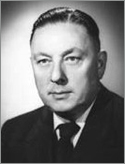 February 1951
February 1951
Elder Mathew Cowley of the Quorum of the Twelve (pictured at left), who presides over all Asian and Pacific missions of the Church, visits President Edward L. Clissold in Laie and suggests Maoris coming from New Zealand to do temple work should build their traditional houses, sell handicrafts and perform so they could live inexpensively while there. President Clissold thinks this is also a good idea for all visiting Polynesians. This eventually becomes the founding concept for the Polynesian Cultural Center.
March 11, 1951
Elder Cowley publicly shares the idea for a Polynesian village in Laie during his address at the Oahu Stake conference.
April 9, 1951
David O. McKay becomes the ninth president of the Church. A new era for Laie and the Church in Hawaii is about to begin.
June 1951
President McKay sends a delegate to Hawaii to study the details of setting up a college.
Summer 1953
Edward L. Clissold, Zions Securities manager, further discusses the idea of a Polynesian village in Laie with Elder Matthew Cowley and Wendell B. Mendenhall during a trip to Utah. Clissold reports the "widely separated assignments of the three men discouraged any definite planning at that time." (Elder Cowley dies later this year and further discussions of the Laie project are postponed.)
July 21, 1954
The First Presidency announces the establishment of The Church College of Hawaii, a two-year junior college.
August 1954
President Reuben D. Law and two associates spend a month on Oahu and recommend establishing the university in Kaneohe. President McKay responds that the school will be in Laie.
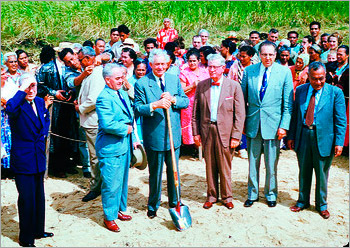 February 12, 1955
February 12, 1955
President McKay, standing in the middle of sugarcane field in Laie, breaks ground for the Church College of Hawaii and offers a far-reaching glimpse of the school's impact:
"We dedicate our actions in this service unto thee and unto thy glory and to the salvation of the children of men, that this college, and the temple, and the town of Laie may become a missionary factor, influencing not thousands, not tens of thousands, but millions of people who will come seeking to know what this town and it's significance are."
He also prophesies that "…from this school, I tell you, will go men and women whose influence will be felt towards the establishment of peace internationally. Four hundred and fifty million people waiting to hear the message over in China, a noble race. I've met them. I don't know how many million in Japan. You prepare to go and carry that message. Three hundred and fifty million down in India. We have scarcely touched these great nations...."
At this time the total annual visitor count to Hawaii is approximately 110,000; but since the Polynesian Cultural Center opened in 1963, over 37-million people have visited Laie. Also at the time of the groundbreaking, the Continuing Committee tells President McKay the college can open in September 1956. He responds: "I would like it to begin in the fall of 1955."
September 1, 1955
Under the direction of Wendell B. Mendenhall, the Church begins a labor missionary program in the Pacific Islands, building hundreds of chapels, the Church College of New Zealand and the New Zealand Temple.
September 26, 1955
Church College of Hawaii begins classes in the Laie Chapel and several war surplus buildings moved to a nearby watermelon patch site.
1957–58
Edward L. Clissold, Wendell B. Mendenhall and others hold a series of discussions about the need to furnish employment for the new Church College of Hawaii students. He said:
"When the need came for finding work for the students, our thoughts turned to tourist dollars and the possibility of getting some of those going around the island in big buses. …We thought of Brother Cowley's prophecy and so out of that grew the first beginnings of the Polynesian Cultural Center…." That name, however, was still several years into the future, and most people referred simply to a "Polynesian village."
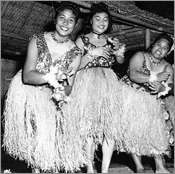 School year 1958–59
School year 1958–59
Edward Clissold calls a meeting about forming a Polynesian group to be trained by the best available talent. With about 75 students and local youth, CCH art professor Wylie Swapp starts up Halau Imi Noeau — "organization seeking traditional knowledge." Hawaiian cultural expert and Church member Mary Kawena Puku'i suggested using the term halau, which up to that point was seldom used for hula or other performing troupes. A small group of the students begins to perform at the International Market Place in Waikiki. Others cultural leaders are hired to assist, including Huihi Hemmingson from New Zealand, Christina Nauahi of Hawaii, Feagaimaali'i Galea'i — a Samoan living in Laie, and Nanasi Fine — a mature Tongan student. (Left, photo caption: Polynesian Institute dancers (left-right) Kalolaine Mataele Soukop, Emeline Uluave Unga and Nanasi (Nancy) Fine perform at the International Market Place)
School year 1959–60
The Polynesian Institute forms as a CCH adjunct and encompasses the student performing group, with Dr. Jerry K. Loveland as the first director. Edward Clissold reports "it became more and more evident that a special place was needed for performances and demonstrations if they were to be developed into attractions for tourists. The first thought was to expand the facilities of the hukilau grounds." Others thought the new center should be located closer to the Temple.
March 8, 1960
Fifty-eight new labor missionaries leave their South Pacific islands to work on the CCH Project Number Two. Also in this year, Edward L. Clissold and Wendell B. Mendenhall approach President David O. McKay about the Polynesian village concept.
April 14–15, 1960
Halau Imi No'eau puts on its first performance, Polynesian Panorama, at the Kaiser Hawaiian Village Dome (now the Hilton Hawaiian Village). The show draws only a small crowd, however it receives a favorable newspaper reviews and the support of many Hawaiian performers at the time.
February 12, 1961
President McKay authorizes funds for planning and developing the Polynesian village, including the services of Church architect Harold Burton and his son, Douglas W. Burton. Soon after, the labor missionaries, who are already in Laie working on the second phase of the permanent CCH campus under the direction of supervisor Joseph F. Wilson, begin initial site work: They dig the beginnings of the village's lagoon between the new CCH campus and the Temple.
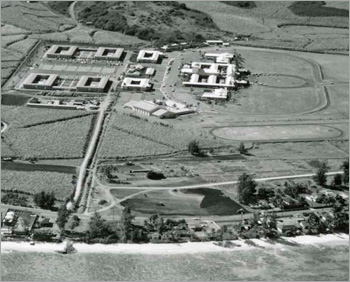 April 14-15, 1961
April 14-15, 1961
Polynesian Panorama's next couple of performances, and subsequent ones in Waikiki draw sellout crowds. Also about this time, Wendell B. Mendenhall organizes a group of master carvers in Temple View, New Zealand, to begin creating panels for a Maori meeting house at what everybody is nowcalling the "Polynesian Village."
November 29, 1961
Elders Delbert L. Stapely and Gordon B. Hinckley of the Quorum of the Twelve, acting on President McKay's directions, review the project and recommend deferring further construction because the site is too close to the Temple. They recommend another site closer to the highway.
January 1962
President McKay approves building the Polynesian Village on a 12-acre taro patch fronting Kamehameha Highway. (At left, not the first . . . but the final site selected for the Center, 1961. Also, see the comment under "Summer 1963 regarding the final name of the PCC.)
February 1962
Labor missionaries begin construction of the Polynesian Village on its existing site.
March 17, 1962
An audience of 3,000-plus watches Polynesian Panorama's first performance at the Waikiki Shell.
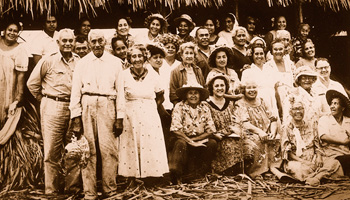 Early 1963
Early 1963
Large groups of volunteers from the local community under the direction of Bishop James Uale (some of them pictured at the right) help prepare the Polynesian Village. For example, Jubilee and Eugenia Logan are called on a labor mission to take charge of the Hawaiian village.
May 1963
Isireli Racule, a respected Methodist teacher, arrives from Fiji to take charge of the Fijian village. About this time, Queen Salote of Tonga charges two skilled builders, Olive and Nafe, to help Nanasi Fine build a replica of her summer palace in the Tongan village. Brother and Sister Tehani are also brought from Tahiti — and assisted by Leila Tehua — to oversee finishing that village.
Summer 1963
A small group of Maori bring the carvings Mendenhall commissioned (see April 14-15, 1961) from New Zealand and start to install them. Soon after, 148 members of the Te Aroha Nui o te Iwi Maori — some of them former labor missionaries — come from New Zealand at their own expense to spend the next six weeks before the planned opening to help put finishing touches on the project.
About this time Edward Clissold asks Wylie Swapp to come up with a better name for the Polynesian Village before his next meeting with President McKay. Swapp calls Clissold at the airport before he leaves for the mainland and suggests the name, Polynesian Cultural Center, which President McKay approves.
August 14, 1963
The First Presidency instructs Wendell B. Mendenhall and Edward L. Clissold to officially organize the Polynesian Cultural Center as a nonprofit corporation, with members of the Pacific Board of Education included among the directors. Mendenhall and Clissold select Zions Securities manager Howard B. Stone to serve as managing director for the nearly-ready Center and tap Tausilinu'u David Hannemann as the Center's first fulltime employee and activity manager (Swapp and several others are also approved as part-time employees).
August 25, 1963
At the first official meeting of the PCC Board of Directors, Vice Chairman Edward L. Clissold says the Center's relationship with the Church College of Hawaii must be completed, and announces that CCH President Richard T. Wootton, Dean of Students Ralph D. Olson, and Professor Jerry K. Loveland, Director of the Polynesia Institute, would become ex officio members of the Board.
Wendell B. Mendenhall serves as the first Chairman of the Board. Other members — all volunteers, until today — include George Q. Cannon, D'Monte Coombs, Owen J. Cook, John A. Elkington, Kenneth Farrer, Lawrence Haneburg, Gus T. Hannemann, William K. Isaacs, Clinton J. Kanahele, D. Lawrence McKay, Max W. Moody, G.W. Poulsen Jr., Howard B. Stone, Paul Su'afilo, Joseph E. Wilson, Charles Wolfgramm and Michel M. Grilikhes.
September 7, 1963
Edward Clissold informs Wylie Swapp the PCC will start to use professional entertainment people to work with PCC productions, including Michel "Mike" Grilikhes — a Peabody Award-winning director and general program executive at CBS in Hollywood; his wife, Hollywood actress Laraine Day; and choreographer Jack Regas as well as professional sound, lighting and public relations people. Swapp decides, "I want to be a college professor," and bows out.
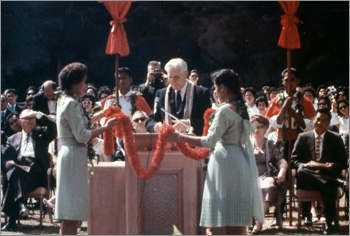 October 12, 1963
October 12, 1963
With over 1,500 people in attendance, President Hugh B. Brown of the First Presidency dedicates the Polynesian Cultural Center (pictured at right, President Brown unties a carnation lei during the dedication ceremony, symbolically representing the opening). Lt. Gov. William S. Richardson (who is part-Hawaiian) represents the State of Hawaii, and Harry Lake, Minister of Finance, represents the New Zealand government. Responding for the islanders are: Sidney Crawford, Maoris; Jacques Drollet, Tahiti; Charles Wolfgramm, Tonga; Manu Fatafehe, Fijians; Percy Rivers, Samoans; and Mary Kawena Puku'i, Hawaiians.
In his dedicatory prayer, President Brown says:
...We thank Thee for this spot of ground, hallowed and blessed as it is. We thank Thee for the buildings that have been erected here and are to be erected ... We thank Thee for the faith and courage and devotion of brothers and sisters who have devoted themselves unstintingly to the preparation of this spot for the purposes for which it has been erected, and will be employed... I dedicate to Thee, the Lord, these grounds, the buildings built thereon, and all things connected therewith, which have been and are being established for the betterment and uplifting and blessing of the people. May all who have come here see in this Center an effort to bring people of different nations, of different races together in a better exemplification of true brotherhood...
...We dedicate it all for the purposes for which it has been established and pray that Thy Holy Spirit may be here, that everyone who comes onto these grounds or into any of these buildings, representing as they do the various Polynesian groups, may feel the Spirit of true brotherhood, of true worship, and a better understanding of Thee, the Lord... And may the Spirit that is here today radiate throughou the world, that others seeing and feeling the effects thereof may emulate what is here being done to Thy name's honor and glory and to the good and benefit of the people.
After touring the villages, the audience enthusiastically receives the first show, A Night Through Polynesia. The Te Aroha Nui Maori group dominates the first night show and soon after travel to the U.S. mainland to put on concerts in California and Utah before returning home.
October 14, 1963
The Center opens for regular business from 10 a.m. to 5 p.m. daily (closed Sundays), except for a Saturday evening show. Initially, tickets cost $1.50 per adult and 75 cents per child.
December 1963
The original version of the Pineapple Deelite is born.
January 1964
Over the next few months, the PCC board respectively asks Edward L. Clissold, Rad Robinson and Mike Grilikhes to assume general management of the Cultural Center.
February 1964
Popular television entertainer Art Linkletter visits the Polynesian Cultural Center. Other VIP visitors in the early years include Lynda Bird Johnson, daughter of U.S. President Lyndon B. Johnson; Hawaii's U.S. Senator Hyrum Fong; Steve Allen; Kirk Douglas and family; Jane Powell; Arthur Godfrey, Henry Fonda, Tony Bennett, Steve Allen and Jayne Meadows, Edie Adams, Johnny Mathis, Tony Martin, James Garner and others.
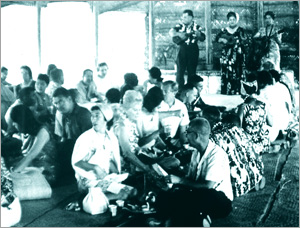 July 4, 1964
July 4, 1964
The PCC inaugurates its first major food services, the "Polynesian Feast" (pictured at left), in the Samoan village maota (Chief's House). Guests sit on mats on the floor and enjoy traditional foods from Samoa, Tonga, Fiji, Aotearoa, Tahiti and Hawaii.
August 5, 1964
Ground is broken for the Laniloa Lodge (which was demolished on January 25, 2010, to make way for a new, larger hotel on the same site).
October 1964
The PCC Board of Directors selects Lester W. Hawthorne as the Center's general manager. Soon after he moves the PCC front entrance closer to the snack bar and gift shop. Also about this time Hawthorne hires Bert Thomas as the Center's first sales and marketing manager, who sets up commission arrangements with various tour operators. Center attendance in its first year of operation reaches 175,000.
January 1965
President David O. McKay names Elder Howard W. Hunter of the Twelve as President & Chairman of the Board of the Polynesian Cultural Center.
Early 1965
Les Hawthorne rents an umbrella stand with a phone in the International Market Place — the PCC's first sales "office" in Waikiki — which is open from 8 a.m. to 10 p.m.
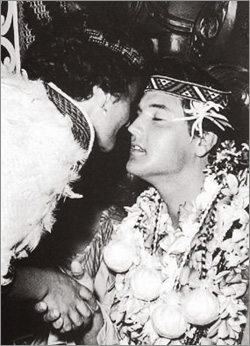 June 1965
June 1965
Singing star Elvis Presley spends one week at the Polynesian Cultural Center filming a portion of Paradise Hawaiian Style. "The King" transposes PCC's signature song, Bula Laie, written by Fijian Village chief Ratu Isireli Racule, into Drums of the Islands as part of the production. (Elvis is pictured at right sharing a Maori greeting.)
January 1966
The PCC Board of Directors names F. Wayne Glaus as general manager.
Early 1966
PCC maintenance crews complete the original version of the Hale Kuai; food service people being serving the Center's Hibiscus Buffet there.
February 1966
The Church-owned Laniloa Lodge, a motel adjacent to the main entrance of the Polynesian Cultural Center, opens.
March 1966
About this time, PCC now offers its evening show on Monday, Wednesday, Friday and Saturday during the summer, and Wednesday, Friday and Saturday during the remainder of the year.
April 10, 1966
The PCC premieres its Canoe Pageant, originally with only Samoan and Maori performers.
Summer 1966
The PCC premieres its new night show, Isles of Paradise. An admission, dinner and show ticket for an adult costs $7.90 and $4.60 for children under 12. General admission costs $2.10 (and $1.05 for children).
August 31, 1966
The PCC night show closes while about 175 PCC performers begin a two-week promotional tour on the mainland, including a four-night run at the Hollywood Bowl in California. Over 100,000 people attend Festival Polynesia. The group also appears on the most popular TV variety program of the day, The Ed Sullivan Show. They then travel by train to Utah for six performances at Highland High School and two visits to President David O. McKay.
December 1966
The PCC becomes profitable.
July 1967
The PCC stages its first island fashion show, with one couple from each village as models.
October 1967
The PCC Board of Directors names Lawrence Haneburg, a Hawaiian, as general manager.
August 1968
The PCC board names Honolulu business leader George Q. Cannon as general manager; Vernon R. Hardisty, a retired Air Force officer, as Director of Operations; and Stephen Bennett as Director of Marketing. About this time the Center establishes a Waikiki Sales Office in the Bank of Hawaii Building on Kalakaua Avenue.
December 31, 1968
For the first time over one million guests in a single year attend the Polynesian Cultural Center.
1970
By the end of the year, the PCC Board of Directors begins discussions on expansion.
September 1970
During his trip to mark the 15th anniversary of the Church College of Hawaii, Joseph Fielding Smith becomes the first president of The Church of Jesus Christ of Latter-day Saints to visit the Polynesian Cultural Center.
February 1972
Tavita Fitisemanu succeeds Mauga Tapusoa as "chief" of the Samoan village and William "Pop" Sproat takes over leadership of the Hawaiian village from Eugenia "Mom" Logan.
October 5, 1972
The PCC introduces the Laie Tour. Also about this time Church President Harold B. Lee approves expansion plans for the Center.
1973
Tom Kershaw becomes "chief" of the Maori Village.
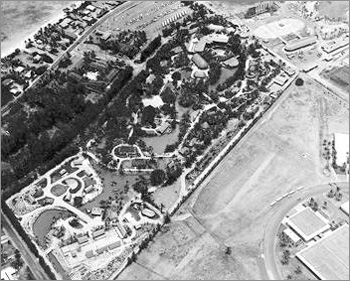 1974
1974
PCC announces a major expansion project that eventually includes adding a large new amphitheater as well as relocating the Hawaiian Village and adding the Marquesan tohua or ceremonial compound. (Left photo caption: The new theater is at the top right; the new Hawaiian Village is at the lower-left, with the Marquesan tohua to the right of it.)
May 12, 1974
The Center opens the new Marquesan tohua.
March 1975
The Board of Directors appoints William H. Cravens (who is part-Samoan) as general manager.
June 1, 1975
The Center opens its newly relocated and enlarged Hawaiian village.
November 1975
Adi Litiana Maopa (also known as the Radi ni Waimaro), granddaughter of Fiji's paramount chief, Ratu Cakobau (and aunt of PCC's Lulu Sigavata), "reigns" over the PCC's Fijian cultural celebration.
April 1976
Elder Marvin J. Ashton, a member of the Quorum of the Twelve and Chairman of the PCC Board of Directors, is named president of the Polynesian Cultural Center.
July 4, 1976
Elder Howard W. Hunter dedicates the major expansion of the Polynesian Cultural Center, including a new front entrance, the new Hawaiian village, the 2,531-seat amphitheater (which is later expanded to as many as 2,775 seats) and other cultural and service buildings. The latter category includes the Center's new administrative and business offices (currently the home of MIS).
October 20, 1976
BYU–Hawaii presents an honorary Doctorate of Humanities degree to HRH King Taufa'ahau Tupou IV of Tonga.
May 1977
PCC student worker Tulani Uale wins the Miss Samoa-Hawaii title.
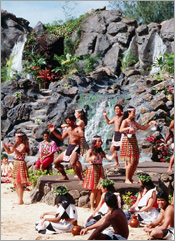 July 1977
July 1977
The PCC premieres a new matinee show (pictured at left) featuring Polynesian music from ancient to modern times, including even a Christian choir.
Fall 1977
Jay Akoi and Carl Fonoimoana undergo food service and purchasing training with the Marriott Corporation in Washington D.C. (Soon after the Marriott organization invites the PCC to join its purchasing program, an association that continues to this day.)
November 1977
TV star Lee Majors films part of a segment of his popular show, Six Million Dollar Man, at the PCC.
Spring 1978
A seven-person crew from the Church-owned Bonneville Corporation spends two weeks at the Center putting together a half-hour documentary film, The Aloha Experiment, designed to be shown on the Public Broadcasting System.
January 12, 1979
Howard W. Hunter dedicates the new Gateway Restaurant, which had been created inside the Orientation Building.
February 1979
The PCC introduces its Lei Alii Seasonal Pass — good for a calendar year — at a cost of $10 per adult and $5 per child (ages 5–11): The pass allows holders free admission to the Center and a 20% discount on the Hibiscus Buffet and evening show.
Spring 1979
PCC's half-hour documentary film, The Aloha Experiment, receives the Creative Excellence Award out of about 800 entries from 12 countries at the 12th annual U.S. Industrial Film Festival in New York City.
August 1979
The PCC completes and launches a new six-man Hawaiian paddling canoe, christened Lokahi, at Hukilau Beach.
Also this month Cleo Smith is named "chief" of the Maori village, succeeding John Elkington.
August 20, 1979
Recording star Englebert Humperdinck visits the PCC.
September 22, 1979
The combined Polynesian Cultural Center-BYU–Hawaii float — with a theme of "Peoples of Hawaii" - Children Born of One God — captures the Grand Sweepstakes Award in the annual Aloha Week parade.
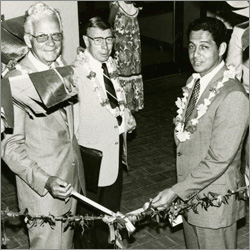 January 25, 1980
January 25, 1980
Elder Marvin J. Ashton of the Quorum of the Twelve and President of the Polynesian Cultural Center dedicates the Lorenzo R. Snow Administration Building on the BYU-Hawaii's campus: The PCC soon after moves its administrative and business offices into about 40 percent of the building closest to the Center. (In the photo at the left, left-right, Elder Ashton, BYUH President Dan Andersen and PCC General Manager William H. Cravens untie the traditional maile lei, marking the opening of the new Admin Building.)
This year the PCC sponsors the hula halau established by Bill Wallace III, Keith Awai, Enoch Kaina and Cy Bridges.
June 4, 1980
At the request of CINCPAC (Commander-in-Chief Pacific), the Polynesian Cultural Center hosts People's Republic of China Vice-Premier Geng Biao, the first high-ranking leader from that country to visit, and 14 Chinese generals. This begins a lasting relationship between the PCC and China. Early discussions focus on helping develop a cultural center in China and sending exchange personnel from there to train at PCC.
June 29 – July 12, 1980
PCC's Cy Bridges joins the Hawaiian delegation at the Pacific Festival of Arts in Papua New Guinea.
October 17, 1980
The PCC honors nine of its own "living treasures" for their mastery of traditional Polynesian cultures: Lagalaga Alo, weaving arts; Epanaia Whaanga Christy, carving arts; Ana Fanene, weaving arts; Eugenia "Ma" Logan, Hawaiiana; Sarah Moanikealanapuamakahikina Wood Naluai, hula and Hawaiian performing arts; Isireli Racule, Fijian arts; William "Pop" Sproat, Hawaiian oral traditions; Mauga Tapusoa, Samoan oral traditions; and Tevita Alamoti Taumoepeau, Tongan oral traditions.
October 1980
Joseph Ah Quin succeeds William "Pop" Sproat, who retires as "chief" of the Hawaiian Village; and Iona Teriipaia succeeds Taumata Mapuhi as "chief" of the Tahitian Village.
December 8, 1980
Popular TV personality Mike Douglas films one of his shows at the Polynesian Cultural Center. PCC's Justin Uale gets picked for a speaking part. By the end of this year, total cumulative attendance at PCC surpasses the 10-million mark.
December 20, 1980
The PCC honors 26 crew members of the Hawaiian sailing ship Hokulea, which at this point had completed two round-trips to Tahiti using only traditional wayfinding.
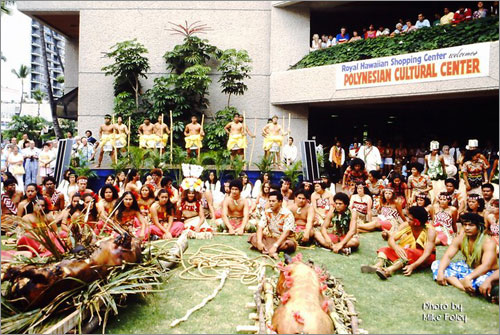
June 16, 1981
The Polynesian Cultural Center relocates its Waikiki Sales and Marketing office and Waikiki Ticket Office from the Bank of Hawaii Building to the Royal Hawaiian Shopping Center (Building C, third floor and first floor, respectively). A large contingent of PCC villagers put on a spectacular presentation (pictured above), complete with the presentation of cooked pigs, to mark the occasion.
August 1981
PCC Properties Inc., a travel agency subsidiary of the Polynesian Cultural Center, opens a new office in the front entrance building. Also this month, the first six interns from the People's Republic of China come to Laie as part of the joint BYU-Hawaii/Polynesian Cultural Center Asian Executive Management program:
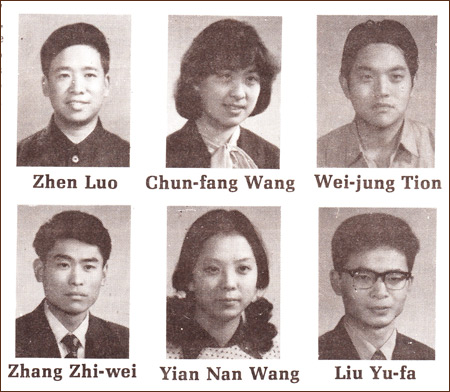
January 1982
The PCC converts the former board room in the old Administration Building into a video studio.
February 19, 1982
BYU–Hawaii and the Polynesian Cultural Center stage another Na Makua Mahalo Ia (The Venerable Ones we Honor) program, chaired by Dr. Ishmael Stagner, honoring the following for their contributions to Hawaii's culture: Lena Guerrero, musician and kumu hula; Sally Wood Nalua'i, kumu hula for the first 14 years at the Polynesian Cultural Center; Kau'i Zuttermeister, kumu hula Harriet N_ (non-Mormon), Moloka'i kumu hula; Eleanor Hoke Hiram, probably the last of the temple-trained kapu hula dancers; Emma Kapi'olani Sharpe (non-Mormon), musician and composer; Sarah Ka'ilikea, expert in menehune hula; Andy Cummings, musician and composer; Alfred Apaka Sr., singer and father of Alfred Apaka Jr.; Theodore Kelsey (non-Mormon), Hawaiian language expert; Solomon Bright Sr. (non-Mormon), musician and composer; and Sarah Pule, musician and composer.
Also this month, the PCC sponsors Reservations employee Maria Fonoimoana's run in the Miss Hawaii Pageant; and about this time, the PCC Brass Band begins performing its afternoon concerts in the new Gazebo built over the lagoon between the Gateway and the Pacific Theater.
March 12, 1982
The PCC honors Hawaii State Gov. George Ariyoshi, who lived in Laie as a child and attended Laie Elementary School for several years.
October 6, 1982
PCC villagers welcome early-morning guests with the new half-hour Fiafia Festival program and flag-raising ceremony.
November 23, 1982
Hurricane 'Iwa temporarily closes down BYU–Hawaii, the Temple and the Polynesian Cultural Center.
December 15, 1982
PCC leaders break ground for a new 18,000 square-foot employee building and a 31,000 square-foot maintenance and purchasing complex. Plans, tentatively calling for an August 1983 completion, also include a new tram terminal near the employee gate and extending the access road completely around the back or mauka side of the PCC, giving the Maintenance Department direct access to Kamehameha Highway.
Also this month, the Maori Village opens its new Carver's Hut.
January 1983
The Board of Directors names William H. Cravens, formerly General Manager and Vice President, as the president of the Polynesian Cultural Center; and Carl Fonoimoana as Executive Vice President.
April 1983
The Hawaii State Senate honors the Polynesian Cultural Center as it celebrates its 20th anniversary. At this time the Center puts together several ad hoc performing teams and with the assistance of the Ketchum PR Agency conducts promotional tours of key U.S. mainland cities, including Los Angeles, San Francisco, Portland, Seattle (and Vancouver, B.C.), Salt Lake City, Dallas, Chicago, and New York City. These tours eventually lead to the establishment of a standing Promo Team.
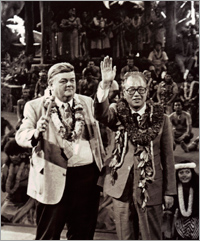 April 12, 1983
April 12, 1983
Ralph G. Rodgers Jr., a former missionary and mission president in Samoa as well as a member of the Polynesian Cultural Center Board of Directors, succeeds William H. Cravens as PCC general manager.
July 1983
The PCC launches its latest night show, This is Polynesia.
January 7, 1984
People's Republic of China Premier Zhao Ziyang, as part of his official visit to the United States, tours BYU–Hawaii and the Polynesian Cultural Center — the longest single activity and the only cultural event on the delegation's itinerary. About a year later it is discovered that during the time of Premier Zhao's visit, his daughter, Wang Yian Nan, had participated incognito as one of the first six Chinese interns in the PCC/BYUH Asian Executive Management program. (In the picture at the left PCC President Ralph G. Rodgers Jr. had just introduced Premiere Zhao to the audience comprised of community members who had gone through security checks to get into the the special daytime show.)
March 3, 1984
BYU–Hawaii and the Polynesian Cultural Center stage the third annual Na Makua Mahalo Ia (The Venerable Ones we Honor) program honoring LDS members and others who have contributed significantly to Hawaii culture, including Vicki I'i Rodrigues, Silver Piliwale, Tau and Rose Moe, the Farden family, the Beamer family, Jimmy Kaholokula, R. Alexander Anderson, Charles Kenn, Wylie Swapp and Rose Joshua.
Spring 1984
PCC Maintenance crews and community volunteers begin a six-week series of projects — many of them overnight — to re-landscape the Center's villages, creating "mountains" and otherwise visually separating one village from the next, as well as winding pathways, waterfalls and new landscaping to beautify the grounds.
May 1984
The Cultural Center leases it gift shops to Host International, a division of the Marriott Corporation. Also at the end of this month, the Center's subsidiary, PCC Properties, Inc., closes its travel agency.
June 29, 1984
The Aotearoa Village gets a new entry gate created by master carver Uncle Barney Christy with Kawika Eskaran, Kyle Ālō, Chad Keli'iliki and Raha Elkington.
July 12, 1984
PCC opens the Yoshimura Store, a snack shop patterned after Hawaiian plantation stores, near what is now the Hukilau Theater.
July 25, 1984
The Polynesian Cultural Center dedicates its new Mission Complex (now called the Hawaii Mission Settlement) featuring a recreated 1850s-era missionary home and chapel. The bell over the chapel was originally used at the Latter-day Saint chapel in Pulehu, Maui — one of the first in Hawaii. There's also a fire hydrant from Iosepa, Skull Valley, Utah.
November 1, 1984
Elder Ivin and Sister Pearl Gee from Lander, Wyoming, are the first of many senior missionaries to serve at the PCC.
May 27, 1985
Skilled craftsmen on Kabara in the Lau Islands of Fiji cut down a large vesi tree to begin work on creating an all-wood, traditional 40-foot camakau outrigger sailing canoe commissioned by and for the Polynesian Cultural Center.
July 1, 1985
Chinese President Li Xiannian tours PCC.
Also this Year Network Photo takes over the Center's fledgling visitor photo operation as an independent concession with two employees and renames it Photo Polynesia.
Fall 1985
The Polynesian Cultural Center begins sponsoring the Hawaii State Teacher of the Year awards, presenting the overall winner with a $2,000 prize and each of the other district winners with a $500 prize.
November 11, 1985
The Polynesian Cultural Center donates $50,000 to the Aloha Liberty Foundation, a Hawaii statewide campaign to raise funds for the restoration of the Statue of Liberty in New York Harbor: PCC President Ralph G. Rodgers Jr. is co-chairman of the campaign and Reg Schwenke, PCC Director of Public Relations, serves as the foundation president).
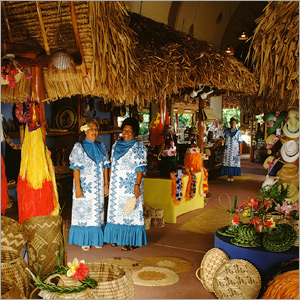 January 1, 1986
January 1, 1986
The Pageant of the Long Canoes shifts from the lagoon into the PCC's original theater, which has been renovated to include a water-stage fed by an artesian well and a large tiki speaker tower. Also this month, the Center opens the Market Place (pictured at right) in the large building behind the Gateway. Several weeks later the Center also dedicates Whaling Wall IX, a large mural painted on the side of the building by well-known marine artist Wyland (it was not possible to preserve the mural when this building was later relocated: See the Timeline listings under July 1993 and July 13, 1996).
March 1, 1986
BYU–Hawaii and the Polynesian Cultural Center stage the fourth Na Makua Mahalo Ia (The Venerable Ones We Honor) program to recognize those who have contributed to Hawaii's culture, including Martha Hohu, Genoa Keawe, Bina Mossman, Sarah Nakoa, Charles K.L. Davis and the Lake family, Kent Ghirard, and Albert Like.
March 24, 1986
Fiji Prime Minister Ratu Sir Kamisese Mara officially presents the Fijian camakau sailing canoe commissioned by the Center and built on the Lau Island of Kambara. The Center proudly displays the camakau in the Market Place (until the building is relocated, see the Timeline listing under July 1993). It now has a permanent home in the Fijian Village.
May 2, 1987
The Polynesian Cultural Center launches its annual Sterling Scholar Awards program, based on a similar program in Utah, to honor outstanding high school seniors throughout Hawaii.
August 1987
Villagers sing farewell songs to guests coming by as part of a new final canoe ride of the day initiative.
April 1988
The PCC begins its Ambassador fine dining service.
July 8, 1988
Elder Marvin J. Ashton of the Quorum of the Twelve and PCC Chairman, rededicates the newly relocated Tonga Village, which was moved to make way for the new IMAX™ Theater (later renamed the Hukilau Theater).
Also at this time, James P. Christensen, a former missionary and mission president in Tonga, succeeds Ralph G. Rodgers Jr. as president of the Polynesian Cultural Center; and this month Elders Dallin H. Oaks and Joseph B. Wirthlin of the Quorum of the Twelve become Chairman and Vice-Chairman, respectively, of the PCC Board of Directors.
Also about this time the PCC converts the snack bar closest to the Pacific Theater into the Alii Luau. It's so popular that at one point the entertainment stage is hung over the lagoon to make more room for dining tables.
September 2, 1988
The PCC launches its new Ali'i Luau in The Lanai section of the Gateway, with over 600 travel industry people from Waikiki in attendance.
March 18, 1989
The fifth Na Makua Mahalo Ia program, cosponsored by BYU–Hawaii and the Polynesian Cultural Center, honors a long list of "venerable seniors" for their contributions to Hawaii culture, including Thomas Au, George and Jean Ariyoshi, Kent Bowman, Gladys Brandt, Herman and Freda Gomes, Wayne Harada, Rubellite Johnson, Lani Kalama, Blossom Kaipo, Eddie Kamae, Maraea Kamae, Joe Keawe, Christina Nauahi Kekau'oha, Mary Kovich, Mae Lobenstein, Eugenia Logan, "Lucky Luck," Rachel Mahuiki, Edith McKinzie, Dr. Donald K. Mitchell, George Naope and Anna Lindsey Perry-Fiske.
July 3, 1989
Voyages of the Pacific, with original music composed by PCC musician Larry Reis, replaces The Beat of Polynesia as the PCC's canoe pageant.
August 18, 1989
The hit TV show Full House — starring the Olsen twins (Ashley and Mary Kate) as well as John Stamos — films most of a half-hour segment at the PCC.
November 11, 1989
PCC officials and the Latter-day Saint Area President break ground for the Center's new large-format theater (later named the Hukilau Theater).
August 1990
Former Easter Island governor Sergio Rapu,and his wife, Cynthia, join the PCC staff.
October 1990
Twenty-five performers and leaders from the Polynesian Cultural Center participate in the First China International Folk Arts Festival in Beijing, further strengthening relations between the People's Republic of China and PCC.
October 19, 1990
TThe PCC Brass Band performs for U.S. President George H.W. Bush during a reception in Waikiki.
November 1990
The PCC holds a "sneak preview" of its new large-format film, Polynesian Oddysey, for a Hawaii International Film Festival audience of approximately 400 in the soon-to-be-completed 600-seat Hukilau Theater (briefly called the Hawaiimax Theater). The film's director, Academy Award winner Kieth Merrill, was on hand to discuss the making of the film. Merrill and crew created the film on location in Hawaii and the South Pacific in the months leading up to the premier.
December 1990
PCC's Management Information Services (MIS) staff installed a new mainframe computer, increasing capacity from 1 to 1.5 gigabytes and significant speeding up procedures. For example, payroll processing was reduced from 3-4 hours to about 30 minutes.
January 18, 1991
President Thomas S. Monson of the First Presidency dedicates the new 600-seat Hukilau Theater, the first of its kind in Hawaii.
June 1991
As it nears completion, the China Folk Cultural Villages in Shenzhen, China, proposes beginning a "sister cultural center" agreement with the PCC.
June 21, 1991
Eric B. Shumway, Academic Vice President of BYU–Hawaii — as well as a former missionary, mission president and Tongan language scholar — succeeds James P. Christensen as president of the Polynesian Cultural Center on an interim basis.
July 6, 1991
PCC premieres its latest night show, Mana! The Spirit of Our People.
October 1991
The Board of Directors names Lester W.B. Moore as President & CEO of the Polynesian Cultural Center.
January 4, 1992
Over 600 volunteers from the four Laie-based Church stakes help perform a "million dollar facelift" on the PCC grounds. As part of this project, PCC Maintenance crews spend several days widening walkways, dredging the lagoon, building eight canoe landings and brightening the Center.
January 1992
Hawaii's ozeki-ranked Samoan sumotori, Saleva'a Atisanoe, who wrestles under the ring name Konishiki, films part of the Japanese Fuji TV Network special at the Polynesian Cultural Center on his upcoming wedding.
Also this month, Kalolaine Mataele Soukop, a former Halau Imi No'eau member and original PCC performer, becomes the first female member of the Center's Board of Directors.
July 1992
During a visit by Princess Salote-Pilolevu Tuita of the Kingdom of Tonga, she asks BYU–Hawaii Academic Vice President and Tongan scholar Eric Shumway to announce on her behalf that her father, the king, would bestow the chiefly title Mafi Fakapotu on PCC President & CEO Lester W.B. Moore.
August 10, 1992
On behalf of the China Folk Cultural Villages in Shenzhen, Ma Chi Man comes to Laie to sign a formal "sister cultural center" agreement with the PCC.
September 11, 1992
Hurricane 'Iniki strikes Hawaii, doing extensive damage on some islands and closing the Polynesian Cultural Center for a day.
November 1992
The Polynesian Cultural Center formally enters into an agreement to provide special management training and consulting support to help develop a new cultural theme attraction in China.
March 1993
"Wonder Woman," Araipu Tutai Pukerua from the Cook Islands, performed her amazing feat of husking a dried coconut with her teeth while dancing . . . for two weeks in the Maori Village.
May 24-29, 1993
The Center launches a series of special events, starting with its first Samoan World Fireknife Dance Competition. PCC "coconut man" Chief Sielu Avea wins the first title.
July 1993
The PCC Board of Directors approves converting the Market Place site into a new Food Processing and Distribution Center. (The Market Place would eventually be moved to the back side of the Hukilau Theater and renamed the Hale Ohana.) The plans called for large kitchen and bakery facilities, offices, dry and perishable storage areas, as well as a mobile system of hot and refrigerated modules to deliver cooked food to the various serving venues throughout the Center.
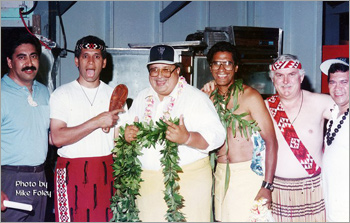 July 10–17, 1993
July 10–17, 1993
Thousands of alumni and friends help the Center celebrate its 30th anniversary. (Left-right: The late Winton Ria, Royal Nikora and "Uncle" Bill Wallace III; Bobby Kauo, now-retired BYUH professor Max Stanton and Etua Tahauri)
July 17, 1993
HRH King Taufa'ahau Tupou IV of Tonga comes to Laie to bestow the chiefly title Mafi Fakapotu — "champion of the rear guard" — on Lester W.B. Moore, President & CEO of the Polynesian Cultural Center.
August 28, 1993
Continuing with the special events initiative, the PCC stages Musika…Voices of Samoa, a Samoan choir competition.
November 1993
As another special event, the Cultural Center presents a series of performances by Fijian firewalkers from the island of Beqa.
February 1994
Continuing to build on the special events initiative, the PCC presents a series of performances by Tjapukai, a highly acclaimed Australian aborigine dance group from Kuranda (near Cairns), Queensland.
March 21-26, 1994
In its next special event, the PCC features a Rarotongan group and "Wonder Woman," a Cook Island Maori who husks coconuts with her teeth.
March 26, 1994
The Stave Falls Scottish Dancers, a Canadian cultural group, performs at the PCC.
April 1994
The PCC's advertising agency, Ogilvy & Mather-Hawaii, wins the Center's first advertising Pele Award in the prestigious American Advertising Federation Awards Show, District 13, for its special event firewalkers ad. The AAFA also recognizes the Center with a first place for Excellence in Printed Materials for the King of Tonga Mafi Fakapotu investiture invitation (of August 1993); second place in the Newspaper category for the Fijian firewalker ad; and second place in the Non-broadcast Video brandprint statement:
The Polynesian Cultural Center is…
In One Day…
All Your Hopes and Dreams…
Of Paradise…
Fulfilled.
May 7, 1994
The People's Republic of China Vice Premier Zou Jiahua visits the Polynesian Cultural Center.
July 8, 1994
The Cultural Center premieres its new canoe pageant, Ancient Legends of Polynesia, on the lagoon. For the previous decade, the canoe show was staged in the Hale Aloha. In preparation, the Center had installed a new audio system along the lagoon's perimeter. The "legends" include: The rainbow princess, Hawaii; the origin of firewalking, Fiji; the origin of the coconut tree, Samoa; Ponga and Puhihuia, New Zealand; the original legend of Tonga's ruling line; and how Rata rescued his parents, Tahiti.
Also this month, the PCC Board of Directors approves building a new $1.3 million shopping plaza at the original Alii Luau location.
July 30 – August 11, 1994
Another special event at the PCC, the Tahitian Black Pearl Festival, features a visiting group from Tahiti and a dance competition.
Summer 1995
The PCC premieres its new night show, Horizons: Where the Sea Meets the Sky.
August 1995
The Public Relations Society of America, Hawaii Chapter, presents its prestigious annual Koa Anvil Award to the Center for its second annual Samoan World Fireknife Championship event held in May 1994.
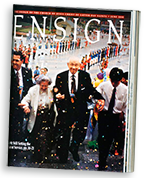 May 28, 1996
May 28, 1996
President Gordon B. Hinckley becomes the first president of the Church to visit the People's Republic of China when the Folk Culture Village in Shenzhen extends him a lavish VIP greeting as "president of the PCC" (pictured at right). President Hinckley was in the area to dedicate the new Hong Kong Temple the day before.
January 18, 1996
Effective at the next regular annual meeting, Elders Dallin H. Oaks and Joseph B. Wirthlin of the Quorum of the Twelve relinquish their respective positions as Chairman and Vice-Chairman of the Polynesian Cultural Center Board of Directors as the Church withdraws General Authorities from the boards of all businesses (except Deseret Management Corporation).
April 19, 1996
The PCC Waikiki Sales and Marketing office officially relocates from the Royal Hawaiian Shopping Center and opens in the Waikiki Trade Center.
June 1996
Theodore M. "Ted" Jacobsen becomes chairman of the PCC Board of Directors.
July 13, 1996
The PCC holds the grand opening of the new Alii Luau in the newly renovated Hale Ohana. The structure, which previously served as the Market Place, has been relocated from behind the Gateway Restaurant to a spot behind the Hukilau Theater.
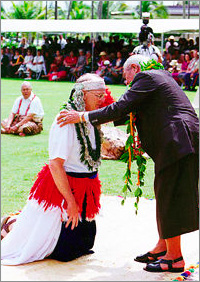 May 10, 1997
May 10, 1997
His Royal Highness Malietoa Tanumafili II, Head of State of Western Samoa (pictured at right in the photo at left), invests PCC President Les Moore with the chiefly title Galumalemana in special ceremonies in front of BYU-Hawaii.
Summer 1997
The PCC Promo Team and other PCC student performers as well as students from the Hong Kong Institute of Religion appear at Window on the World, a sister theme park to the China Folk Culture Village in Shenzhen. The PCC student performers remain for a summer run.
July 1, 1997
Approximately 30 PCC performers participate in the handover ceremonies between Great Britain and the People's Republic of China in Hong Kong. Over 100 million people in China watch the group's performance on national television.
August 18, 1997
The Center opens its new $4 million, 16,000 square-foot Food Preparation and Distribution Center.
September 1997
PCC attendance surpasses 25 million.
October 22, 1997
The Polynesian Cultural Center wins the Hawaii State 'Oihana Maika'i Award of Excellence (analogous to the national Malcolm Baldridge Award).
November 12, 1997
The PCC formally renews its "Sister Cultural Center" relationship with the China Folk Cultural Villages attraction in Shenzhen.
January 1998
The PCC is the featured McExtra program attraction at all 71 McDonald's restaurants in Hawaii.
February 7, 1998
The National Landscape Association honors the Alii Luau Garden at the Polynesian Cultural Center's Hale Ohana with its 1997 National Superior Award for Best Commercial Garden Space.
May 8, 1998
The PCC opens the Kahaki'i fine art gallery, featuring the creative works of Hawaii artists including some of the Center's own.
May 20, 1998
Twenty delegates from the Religion Research Center of the People's Republic of China spend a day at the Polynesian Cultural Center.
June 11, 1998
PCC Cultural Islands Director Cy Bridges delivers a Hawaiian chant for the opening of the Hawaii Convention Center in Waikiki in the morning, and that evening PCC performers help entertain the media and dignitaries attending the event.
September 1998
The Center launches its latest — and still in use — logo in time for the 35th anniversary.
October 3, 1998
The PCC puts on a royal ava ceremony for the Hon. Tuiatua Tupua Tamasese Efi, a paramount Samoan chief, former Prime Minister of Samoa and a current member of parliament on an economic fact-finding tour of Hawaii.
December 1998
Vanna White tapes a portion of the Wheel of Fortune TV show at the PCC. Also this month, the Center's retail outlet opened its Holiday Hut Christmas shop at Windward Mall.
January 1999
The PCC opens its Fale Popo craft shop in the Samoan Village.
February 1999
The BYU-Hawaii Alumni Association honors PCC employee P. Alfred Grace and alumnus Bode Uale, a Hawaii State Family Court judge; and presents retired vice president T. David Hannemann with its Distinguished Service Award.
March 1999
The International Association of Attractions presents the Center with its gold Pinnacle Awards in the print and brochure advertising categories, another gold Pinnacle Award for the best magazine ad series, and a silver award for the best single newspaper display ad as part of its 1998 Brass Rings Awards program.
April 1999
The PCC joins a Laie-based ad hoc informational technology committee the study the potential impact of Y2K — i.e. the possible effects on some computer calculations when the calendar advances from 1999 to 2000.
June 19, 1999
The BYU–Hawaii Alumni Association presents PCC President & CEO Lester W.B. Moore with its Distinguished Service Award during Spring commencement.
October 21, 1999
The Travel Industry Association of America presents the PCC with its Odyssey Award in the Domestic Travel Advertising category for a multi-level advertising campaign at its national gathering in Pittsburgh.
October 23, 1999
The PCC opens its new Hukilau Store in the Hukilau Theater. Some of the original 1948 Laie Hukilau performers join in the celebration.
December 1999
PCC carvers complete 14 panels that will be installed as end pieces on pews in the Kona Hawaii Temple, which is set to open in January 2000.
July 1, 2000
Von D. Orgill succeeds Lester W.B. Moore as President & CEO of the Polynesian Cultural Center.
July 22, 2000
In conjunction with Laie Days, the Hawaii Sesquicentennial Committee sponsors Na Makua Mahalo Ia — a special program honoring those associated with the establishment of the Laie hukilau, Polynesian Institute, Polynesian Panorama and the Polynesian Cultural Center — at the BYU-Hawaii Cannon Activities Center.
Fall 2000
After a thorough review, the PCC begins a comprehensive, multi-year effort to renovate its aging facilities.
December 2000
The Center unveils its new canoe show, Rainbows of Paradise, under the creative direction of Tommy Taurima.
January 2001
Working with the Church Missionary Department, the PCC dramatically increases the number of senior missionaries serving at the Center from an average of eight to as many as 48 at a time. The Center also increases the number of part-time volunteers.
April 2001
The PCC begins a $1 million facelift project on the front entrance that includes a pedestrian-bike path that runs parallel to Kamehameha Highway.
September 2001
With sugarcane leaves becoming scarce as plantations on Oahu close, the PCC sends a crew to Maui to collect the traditional roof thatching material. PCC crews have made similar trips to the Big Island to gather Hawaiian pili grass, which is also used for thatching.
November 3, 2001
Thousands of people throng to Hukilau Beach for the blessing and launching of BYU–Hawaii's 57-foot traditional twin-hulled Hawaiian sailing canoe, the wa'a kaulua Iosepa, which is now berthed in the Hawaiian Village.
March 25, 2002
By special arrangement with the First Presidency and the Honolulu Hawaii Mission, the Center begins complimentary screenings of the Church's large-format film The Testaments in the Hukilau Theater.
June 2002
BYU-Hawaii presents its Presidential Citation to Sione Tuione Pulotu, a former labor missionary and PCC employee, for his contributions to carving the university's sailing canoe, the construction of various traditional buildings at the Polynesian Cultural Center, and other artistic efforts.
November 11, 2002
For the first time, the First Presidency approves the Center to begin a joint work-study scholarship fundraising effort with BYU–Hawaii.
Also this month, Fijian Prime Minister Laisenia Qarase and his wife visit the PCC.
January 2003
A windstorm blows down the large banyan tree that has shaded its name-sake PCC snack bar from the beginning.
January 15, 2003
The PCC Promo Team, along with the combined BYU–Hawaii men and women's choirs, perform during the opening of the Hawaii State Senate.
January 17, 2003
The popular TV game show, Jeopardy, holds a talent search for potential contestants in the Pacific Theater. They select three BYUH faculty members and a Kahuku High teacher.
February 2003
The Center completes a $2.4 million renovation project, installing museum displays in the front entrance, renewing landscaping along Kamehameha Highway and installing 18 new tiki.
February 3, 2003
PCC President Von D. Orgill marks the completion of the Center's five new Easter Island exhibit moai when he and four carvers from Rapa Nui place the eyes in the statues "so they can see." As part of the ceremony the carvers also name the ahu or platform where the moai stand after Tukoihu, the ancient high chief of Rapa Nui credited with starting the practice of carving moai.
February 14, 2003
The Center holds its first function in the Hale Aloha — the original PCC evening show theater, following a $2.4 million renovation project.
March 2003
Hawaiian celebrity chef and "Laie boy" Sam Choy tapes his segment on the Food Network's My Country, My Kitchen program at the PCC.
March 1, 2003
The Banyan Tree Snack Bar reopens following a $1.6 million renovation.
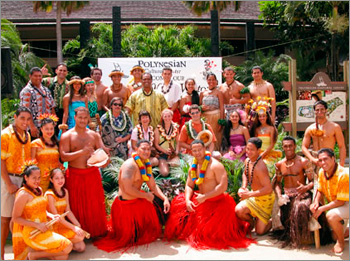 April 25, 2003
April 25, 2003
The Polynesian Cultural Center welcomes its 30-millionth visitor (pictured at right), Dianna Hill, a rural postal carrier from Woodland, California. Dianna and her family were also brought back to participate in the reunion in October.
August 2003
Alii Luau manager Raymond Mokiao and the PCC Promo Team appear on a Hawaiian cooking segment with Al Roker on NBC's Today Show in Manhattan.
August 2003
More than 500 members of the BYU-Hawaii 1st Stake performed their annual super-service project at the PCC to help polish the grounds for the imminent 40th anniversary celebration.
October 20–26, 2003
Thousands of people, including Latter-day Saint President Gordon B. Hinckley, help the Polynesian Cultural Center celebrate its 40th anniversary.
March 2004
PCC Vice President of Human Resources John Muaina, along with BYU-Hawaii Vice President Isileli Kongaika, make the first recruiting visit to the Marquesas Islands.
April 2004
Alberto Hotu, 75-year-old traditional leader and former mayor of Rapa Nui, visits the Center following an invitation in February from Elder Jeffrey R. Holland — the first Latter-day Saint Apostle to visit Easter Island.
February 1, 2004
Over 40,000 people view special screenings of the Church's large-format film, The Testaments. It has been showing in the Hukilau Theater by special permission of The First Presidency and the Hawaii Honolulu Mission, prior to the reopening of the Laie Hawaii Temple Visitors Center which had been closed for a major renovation.
March 2004
PCC Vice President of Human Resources John Muaina makes the Center's first recruiting trip to the Marquesas (in conjunction with BYU–Hawaii).
March 12, 2004
Her Royal Highness Queen Halaevalu Mataaho of the Kingdom of Tonga visits BYU–Hawaii and the Polynesian Cultural Center.
April 1, 2004
The Hawaii Visitor & Convention Bureau bestows its Kahili Award in the Performing Arts and Shows category on the Polynesian Cultural Center's new Alii Luau.
April 2004
PCC publishes its first electronic newsletter [subscribe at: http://www.polynesia.com/email_signup.html]
June 2004
The PCC Promo Team makes its first appearances in Cambodia and Viet Nam (and continued on to appearances in Korea) at the invitation of the City of Honolulu, which has a "sister city" relationship with Hue.
August 2, 2004
The Center serves its first Alii Luau in the newly renovated Hale Kuai — formerly part of a gift shop and site of the PCC's first dedicated dining facility.
October 2004
The PCC's traditional Fijian double-hulled sailing canoe, a camakau, is placed in its new berth, the vale ni camakau, in the Fijian Village. "This is one of the few remaining camakau of its size in the world," says village "chief," Inoke Suguturaga.
January 2005
The Honpa Hangwanji Mission of Hawaii bestows its prestigious "living treasure" award on former labor missionary and Polynesian Cultural Center artisan Sione Tuione Pulotu.
May 2005
The presidents of the PCC and BYU-Hawaii sign an agreement with the China Association for the Development of Tibetan Culture to open the joint Asian Executive Management program to two of their staff.
June 2005
PCC President Von D. Orgill, several of the officers and the Promo Team joined BYU-Hawaii President Eric B. Shumway, Hawaii State Governor Linda Lingle and others as part of an official state delegation to the People's Republic of China.
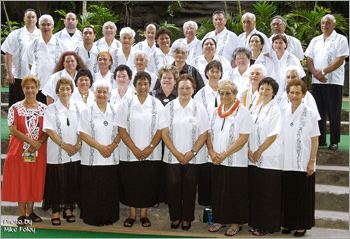 August 5, 2005
August 5, 2005
Forty-eight surviving members of Te Aroha Nui return to the Center to participate in the Whakataetae festival. (Some of them pictured at left; also, see the entry under Summer 1963)
September 2005
The Hawaii State Board of Education praises the Polynesian Cultural Center for its 20 years of sponsoring Teacher of the Year cash prizes.
October 21, 2005
More than 6,000 alumni, special guests and others associated with BYU–Hawaii's 50th anniversary (1955–2005) enjoy a sold-out day at the Polynesian Cultural Center, including Alii Luau dinners and an alumni talent show after the regular Horizons evening show.
October 22, 2005
The PCC Promo Team participates in BYU–Hawaii's golden jubilee parade through Laie.
May 26, 2006
PCC Promo Team member Sina Nauahi captures the Miss Tonga USA title in San Francisco.
Summer 2006
For the first time a PCC performing group appears in Branson, Missouri, at the 3,800-seat Grand Palace Theater.
November 14, 2006
The University of Hawaii system — for its inaugural "Stars of Oceania" program recognizing individuals and organizations that have contributed to development in the Pacific — honored three people from the Polynesian Cultural Center: Kalolaine "Kalo" Mataele Soukop, one of our original dancers, a business woman, and a member of the Board; Tuione Pulotu, a labor missionary and master carver; and Pulefano Galea'i, now a retired senior PCC manager. In addition, the PCC Promo Team presented a ho'okupu performance at the event.
March 26, 2007
The Migrations Museum — an original PCC building that served as the Center's first ticket office and entrance — closes for demolition.
April 6, 2007
The Theater Department begins using the first phase of its renovated backstage area, which includes new offices for instructors, storage rooms and large ventilation units.
May 2007
Vice President of Human Resources "Uncle" John Muaina represents the Center on a BYU–Hawaii Concert Choir tour of China to celebrate 25 years of the two institutions' successful joint Asian Executive Management internship training program.
October 2007
PCC President Von D. Orgill announces private donations have made it possible for the Center to build a $2.65 million halau wa'a (canoe house) in the Hawaiian Village that will become the permanent berth for the BYU-Hawaii sailing canoe Iosepa when it's not at sea.
November 6, 2007
Representatives from the Center, BYU–Hawaii, the joint Presidents' Leadership Council, community and cultural groups, special guests in Laie for the inauguration of new BYUH President Steven C. Wheelwright and participants in the second annual International Business Conference meet in the PCC's Hawaiian village to break ground for the new halau wa'a.
December 2007
PCC Promo Team member Tessi Toluta'u of Laie wins the Miss South Pacific title in Apia, Samoa. She qualifies for the event by winning the Miss Tonga USA crown in May 2007 in Waikiki as Laie's representative, and also the Miss Heilala title in Tonga in July 2007.
March 5, 2008
LDS Philanthropies, which coordinates Church fundraising beyond tithing and fast offerings, announced the creation of the new Matthew Cowley Society to honor donors who make estate planning gift contributions to BYU-Hawaii and/or the Polynesian Cultural Center.
April 1, 2008
The Hawaii Visitors & Convention Bureau awards the PCC's Alii Luau its "Keep It Hawaii" Certificate of Merit.
April 2008
The Hawaii Advertising Federation presents its 2008 Pele Award in the poster design, single posters category, to Element 8 LLC for its Polynesian Cultural Center "Fireknife — Samoa Festival Poster"
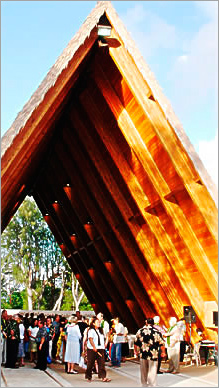 June 25, 2008
June 25, 2008
PCC Board Chairman Mark Willes dedicates the new halau wa'a in the Hawaiian village (pictured at right), where BYU–Hawaii's traditional twin-hulled 57-foot Hawaiian sailing Iosepa will berth when it's not on the water. (Weather delays the canoe's actual arrival in its new home until July 22, 2008.)
July 2008
The Center reorganizes Handicrafts, Concessions, the Event Network and Photo Polynesia concessionaires, and pay-to options under a new In-Center Marketing Department, with Kealii Haverly as its first Director.
October 21–31, 2008
The PCC launches a new special event, the Haunted Lagoon — a scary night-time canoe ride. More than 12,000 people come the first year.
January 2009
The Board of Directors approves promoting P. Alfred Grace, formerly senior vice president of sales and marketing, to the new position of Chief Operating Officer; and having David Ralph succeed Greg Gollaher as Chief Financial Officer.
February 25, 2009
The Board of Directors approves the PCC's new night show, Ha: Breath of Life, soon after watching a conceptual preview in the Pacific Theater.
July 2009
The Public Relations Society of America, Hawaii Chapter, presents McNeil Wilson Communications its Koa Hammer of Excellence Award for its Polynesian Cultural Center "Iosepa: Voyage of Discover" campaign in the Media Relations-Associations/Nonprofit Organizations category.
July 22, 2009
After 14-plus years and more than 4,000 performances, the PCC "drops the final curtain" on its night show, Horizons: Where the Sea meets the Sky. Elder Dallin H. Oakes, a former chairman of the board who has been in Hawaii on vacation, meets with the cast on stage after the final show.
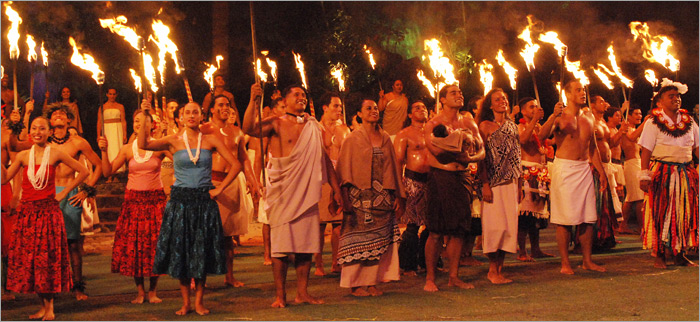
August 14, 2009
The Polynesian Cultural Center officially premieres its new evening show, Ha: Breath of Life, after more than three years of planning and working on the production, months of late-night rehearsals and more than $3 million in improvements. (The finale is pictured above.)
October 29, 2009
The Laie Inn — the motel near the Polynesian Cultural Center originally known as the Laniloa Lodge — closes to the public.
January 25, 2010
Demolition work begins on the Laie Inn to eventually make way for a proposed new hotel on the site.
January 22, 2011
Looking forward to 2013, the PCC announces the formation of its 50th anniversary planning committee with Leilua Logo Apelu, Senior Vice President of Operations, as chairman.
May 7, 2010
Most Reverend Clarence "Larry" Silva, Bishop of the Roman Catholic Diocese of Honolulu, presents a special certificate of appreciation to the Polynesian Cultural Center "in gratitude for the collaboration" of Jonathan Napela and Father Damien during the time they concurrently served Hansen's Disease (leprosy) patients at Kalaupapa, Molokai, in the 1870s.
June 25, 2010
PCC Promo Team member Luçie Wilson wins the 2010 Miss Tahiti title in Papeete.
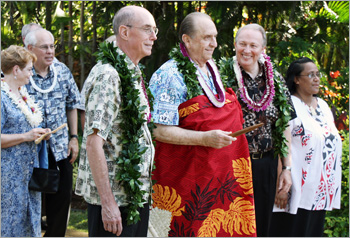 November 19, 2010
November 19, 2010
President Thomas S. Monson along with his First Counselor in the First Presidency, President Henry B. Eyring, their wives and several other General Authorities visit the Polynesian Cultural Center two days before President Monson rededicates the Laie Hawaii Temple. The Temple has been closed for almost two years of extensive renovation work. (Left photo caption: President Thomas S. Monson (center) accepts the carved token to enter the Maori Village. Others in the party (left-right) are Sister and Elder William Walker of the Seventy, President Henry B. Eyring of the First Presidency, PCC President Von D. Orgill and Rahia Makekau.)
December 2010
The Gateway Restaurant closes for extensive renovations.
June 2011
President & CEO Von D. Orgill announces the PCC will spend $38 million over a five-year period to enhance the Center facilities and programs, including a major makeover of the Gateway Restaurant into a multi-purpose building that is nearing completion, expanding the shopping plaza and converting the Hukilau Theater into a 4D experience.
June 25, 2011
As part of an initiative set by the Board of Directors, the Center launches a series of live concerts by featuring Allstar Weekend, a pop group of young men from Southern California, in the Pacific Theater..
Mid-2011
The Honolulu City Council and related City government agencies deliberate on a permit application by Hawaii Reserves, Inc. to build a 222-room hotel on the site of the former Laie Inn next to the Polynesian Cultural Center.
November 10, 2011
The Gateway Restaurant celebrates a grand reopening following renovations that include new entrance portals, food lines and multi-purpose capabilities.
November 2011
Ground is broken to turn the Hukilau Theater into a new 4D virtual experience featuring a new digital Hawaii-themed film.
January 2012
Major renovations begin in the Hawaiian Village, that include replacing everything but the Hale Alii, the Kauaiwiulaokalani Halau Wa'a and the Halau Hula. Major renovations for later in the year are also announced for the Samoan Village that include upgrading most of the fale (houses), creating a new entrance to the village near the Hale Aloha, and replacing the Chief's House (maota) starting in the Fall.
February 11, 2012
The Polynesian Cultural Center features Hawaiian singing stars Natalie Ai Kamauu and special guest, Kapena, as part of a Valentine's package.
July 6, 2013
The Polynesian Cultural Center continues its series of live concerts initiative, showcasing Anuhea & Nesian Nine in the Gateway venue.
August 3, 2012
As part of its 2012 Te Manahua Maori Arts Festival, the PCC concert series features Maori singing stars Ria Hall and Maisey Rika from New Zealand .
September 21, 2012
The Polynesian Cultural Center live concert series features Irie Love and Rebel Souljahz, who perform Hawaiian reggae.
December 14, 2012
President Orgill, with special permission from the First Presidency, announces in an employee Team Meeting that COO P. Alfred Grace will succeed him as president and CEO of the Center when he leaves in a few months to prepare to serve as a mission president. Grace, a New Zealand Maori who started as a student employee in the mid-1980s, will be the first PCC president to come up through the ranks.
January 19, 2013
PCC stages the 23rd annual Moanikeala Hula Festival.
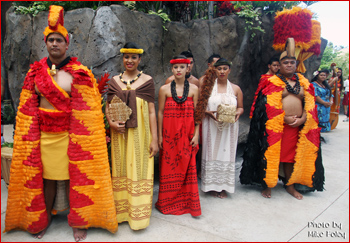 March 29, 2013
March 29, 2013
A large crowd of VIPs, community kūpuna and invited guests attend the grand opening of the newly renovated Hawaiian Journey Theater (formerly the Hukilau Theater), the premier of the PCC's new cinematic experience, Hawaiian Journey — a large-format 12-minute "window" into Hawaiian's deep respect for their islands and its ties to their ancestors, and the official re-opening of the newly renovated Hawaiian Village.
May 8-11, 2013
Top Fireknife dancers come from around the world to the PCC for the 21st annual World Fireknife Championship and the high school Samoan Arts Festival (Saturday morning, May 11).
May 2013
Contractors begin construction projects that 1) demolish the existing Pacific Marketplace and set up temporary gift shops under tents; 2) renovate the Hale Aloha roof; and 3) while the Hale Aloha is temporarily closed, renovate the Samoan Village malae, pave it, and temporary set up a large tent as the home of the new Island Luau.
July (TBD), 2013
PCC puts on its 14th annual Te Mahana Hiro'a o Tahiti Tahitian dancing competition.
August 2-3, 2013
The Polynesian Cultural Center sponsors Te Manahua Maori Cultural Festival, its whakataetae kapa haka (traditional Maori songs and dances competition).
October 1-31, 2013
Throughout the month of October (closed on Sundays), spooky canoe rides and other frights return to the Center's Haunted Lagoon special event.
December 2-21, 2013
Every night (closed on Sundays), PCC cast and community volunteers convert the Center's lagoon into a delightful Christmas experience, as well as associated Holiday Season celebrations.
September 1-8, 2013
The Polynesian Cultural Center will hold a week-long celebration of its 50th anniversary.

